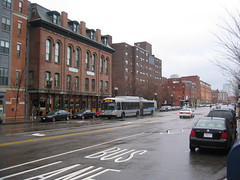Steve Pinkus' observations on what makes "Great Streets" (South End, Boston)
 South End, Boston. All photos by Steve Pinkus.
South End, Boston. All photos by Steve Pinkus.Occasional correspondent Steve Pinkus sent along some photos and observation about the revitalization of the Washington Street area in Boston's South End. (Note also that this area is one of the five case studies in MIT Professor Karl Seidman's report on urban Main Street programs, Revitalizing Commerce for American Cities: A Practitioner’s Guide to Urban Main Street Programs.)
Here's what Steve had to say:
I was just up in Boston visiting family for Thanksgiving and took a lot of photos in the neighborhood I was staying in -- the South End. It's an area that very similar in terms of history, demographics, and physical layout/building stock to U Street/Logan Circle/Shaw or to the H Street, NE Corridor.
Washington Street, which is similar to U Street NW or H Street NE, has BRT service in the form of the Silver Line -- with dedicated bus lanes and high-quality, but fewer, stops with real time next bus information. The Silver Line provides a quick connection into Downtown Boston.
 The Silver Line Bus Rapid Transit vehicle is visible in this photo.
The Silver Line Bus Rapid Transit vehicle is visible in this photo.There is a lot of mixed-use infill development along Washington Street -- with high quality retail (including a new full-scale supermarket) as well as a good portion of mixed income housing. The market rate units are some of the most expensive in Boston -- about $500,000 for a two bedroom condo, for example.
 New housing in Boston's South End. Photo by Steve Pinkus.
New housing in Boston's South End. Photo by Steve Pinkus.Here are a few more things that you don't see in the South End:
* Surface parking lots
* Suburban-style shopping strips with parking in front
* Gas stations.
Virtually all the infill is mixed-use, 5-6 stories, and street-oriented in that the buildings create a solid street wall with limited gaps.
The neighborhood feels safe, the streets are clean, the Silver Line is used by a mix of people -- income, race, etc.I think the South End provides a good vision for what our "Great Streets" neighborhoods can be here in Washington.




0 Comments:
Post a Comment
<< Home